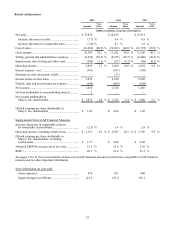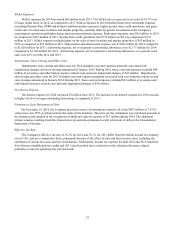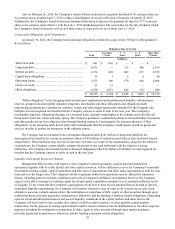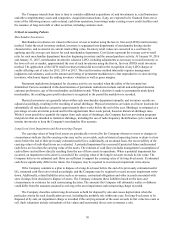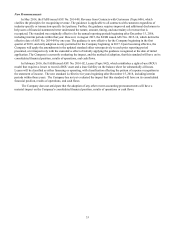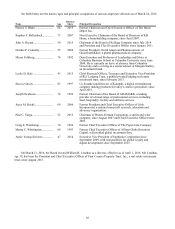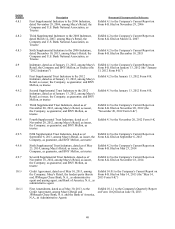Macy's 2015 Annual Report Download - page 37
Download and view the complete annual report
Please find page 37 of the 2015 Macy's annual report below. You can navigate through the pages in the report by either clicking on the pages listed below, or by using the keyword search tool below to find specific information within the annual report.32
The calculation of pension expense and pension liabilities requires the use of a number of assumptions. Changes in
these assumptions can result in different expense and liability amounts, and future actual experience may differ
significantly from current expectations. The Company believes that the most critical assumptions relate to the long-term
rate of return on plan assets (in the case of the Pension Plan) and the discount rate used to determine the present value of
projected benefit obligations.
As of January 31, 2015, the Company lowered the assumed annual long-term rate of return for the Pension Plan's
assets from 7.50% to 7.00% based on expected future returns on the portfolio of assets. The Company develops its
expected long-term rate of return assumption by evaluating input from several professional advisors taking into account the
asset allocation of the portfolio and long-term asset class return expectations, as well as long-term inflation assumptions.
Pension expense increases or decreases as the expected rate of return on the assets of the Pension Plan decreases or
increases, respectively. Lowering or raising the expected long-term rate of return assumption on the Pension Plan's assets
by 0.25% would increase or decrease the estimated 2016 pension expense by approximately $8 million.
The Company discounted its future pension obligations using a weighted-average rate of 4.17% at January 30, 2016
and 3.55% at January 31, 2015 for the Pension Plan and 4.23% at January 30, 2016 and 3.55% at January 31, 2015 for the
SERP. The discount rate used to determine the present value of the Company's Pension Plan and SERP obligations is based
on a yield curve constructed from a portfolio of high quality corporate debt securities with various maturities. Each year's
expected future benefit payments are discounted to their present value at the appropriate yield curve rate, thereby
generating the overall discount rate for Pension Plan and SERP obligations. As the discount rate is reduced or increased,
pension liability would increase or decrease, respectively, and future pension expense would decrease or increase,
respectively. Lowering the discount rates by 0.25% would increase the projected benefit obligations at January 30, 2016 by
approximately $112 million and would decrease estimated 2016 pension expense by approximately $3 million. Increasing
the discount rates by 0.25% from would decrease the projected benefit obligations at January 30, 2016 by approximately
$104 million and would increase estimated 2016 pension expense by approximately $3 million.
Beginning in 2016, the Company is changing the method used to estimate the service and interest cost components of
net periodic benefit costs for the Pension Plan and SERP. Historically, the Company estimated the service and interest cost
components using a single weighted-average discount rate derived from the yield curve used to measure the benefit
obligations. Beginning in 2016, the Company has elected to use a full yield curve approach in the estimation of these
components of net periodic benefit costs. Under this approach, the Company will apply discounting using individual spot
rates from the yield curve composed of the rates of return from a portfolio of high quality corporate debt securities
available at the measurement date. These spot rates align to each of the projected benefit obligations and service cost cash
flows.
The Company is making this change to improve the correlation between projected benefit cash flows and the
corresponding yield curve spot rates and to provide a more precise measurement of service and interest costs. The
Company is accounting for this change as a change in estimate and, accordingly, is being applied prospectively starting in
2016. The 2016 reductions in service cost and interest cost for the Pension Plan and SERP associated with this change are
estimated to be approximately $40 million.


